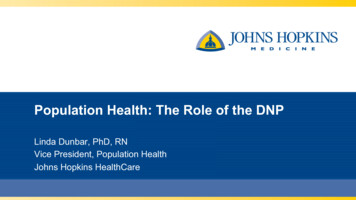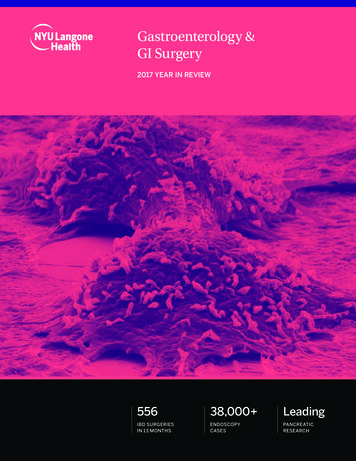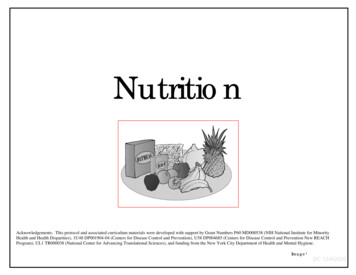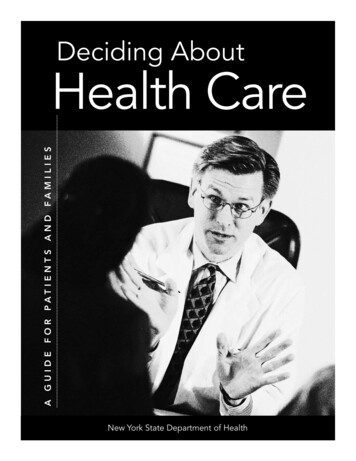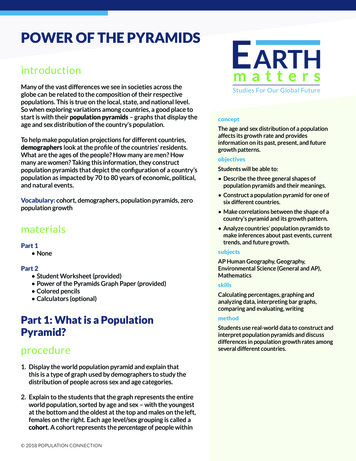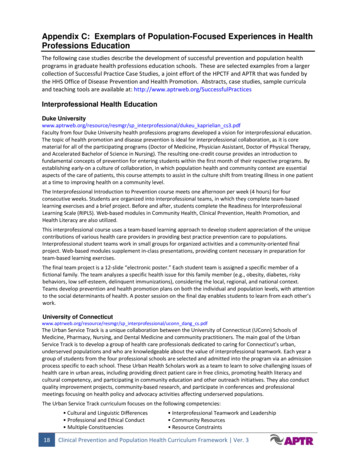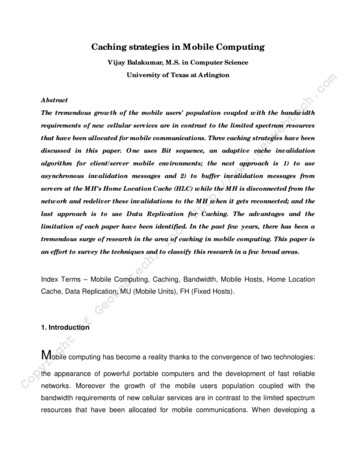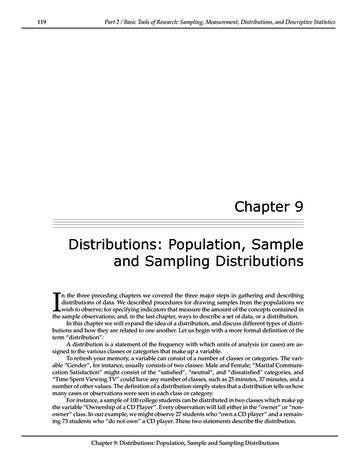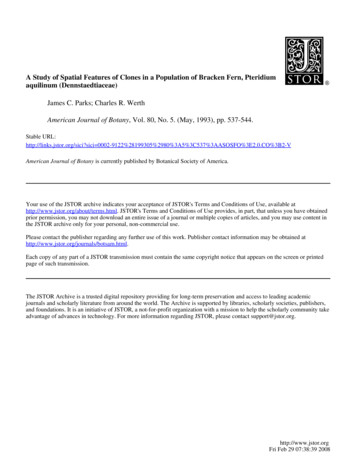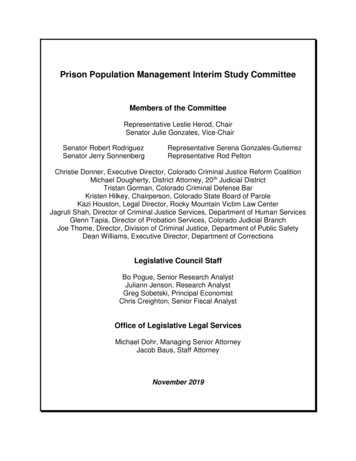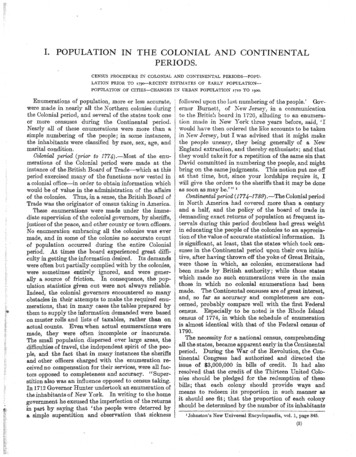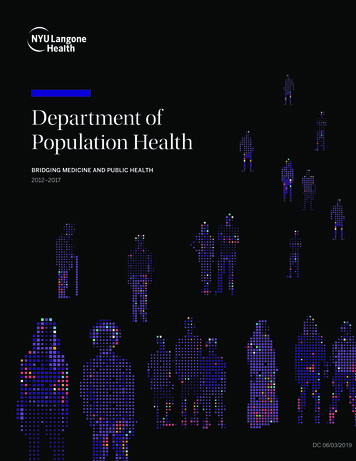
Transcription
Department ofPopulation HealthBRIDGING MEDICINE AND PUBLIC HEALTH2012–2017DC 06/03/2019
ContentsPageWelcome01Shaping the Growth of an Emerging Field02Engaging Comm nity08T rning Information into Insight16Transforming Healthcare22Shaping Policy28Training the Next Generation34Select Publications38Current Research Pro ects40Department Leadership and Faculty42Institutional Leadership44DC 06/03/2019
WelcomeIt’s hard to believe that fve years havepassed since I sat down withDean Robert I. Grossman, MD, andother members of NYU Langone Health’sleadership to discuss the creation of anew Department of Population Health atNYU School of Medicine.MARC N. GOUREVITCH, MD, MPHMuriel G. and George W. Singer Professor of Population HealthProfessor of Medicine and PsychiatryChair, Department of Population HealthTis new department would be dedicated to bridgingthe felds of medicine and public health by exploringand strengthening the connections betweenhealthcare systems and the factors that infuence ourhealth every day in communities, homes, schools,playgrounds, and workplaces.At the time, NYU Langone already had severalprograms extending beyond its walls of the medicalcenter to reach populations across New York City.Yet we lacked a single department that championedthis approach and enabled investigators to movebeyond their disciplinary silos, pool resources,exchange ideas, and create a powerful researchplatform for advancing innovative approaches toimprove the health of urban populations.And so, in 2012, the Department of PopulationHealth was born.From the beginning, our multidisciplinaryefort has brought together an exceptional team ofresearchers from across NYU Langone. Our sharedaim is to lift the gaze of medicine up and out, beyondthe walls of the doctor’s ofce, to encompass theconnections between medicine, society, and people’sdaily lives and to improve outcomes for wholepopulations. Our discipline-spanning approach is acore strength: Our best ideas arise at the interface ofdiferent areas of expertise and from collaborationswith community partners and leaders in the felds ofmedicine, public health, and well-being. Our diversepartnerships—with community organizations,medical colleagues, government agencies, and otherstakeholders—allow us to tackle the populationhealth challenges in the settings in which theymatter most.To realize our twin goals of improving health forall and reducing health inequities between groups,our work embraces four core strategies: engagingcommunities, turning information into insight,transforming healthcare, and shaping policy. Tesethemes are brought to life throughout this report,which tells our story through selected profles ofour work.Over the past fve years, our numbers andthe breadth of our expertise have grown by leapsand bounds. Today, our 90-plus full-time facultymembers and more than 300 staf encompasscommunity-based preventive health, mathematicalmodeling of health interventions, biomedical ethics,early childhood development, and healthcaredelivery system improvements—to name just a fewspecialty areas. Education is central to our mission,and we have developed new and expanded programsto prepare the next generation of physicians,scholars, and leaders in population health.We prize the rigor of our work, refecting our deeproots in academic medicine. In an age of limitedresources, we are committed to understandingwhich approaches are truly efective and why—andto sharing these fndings with our colleagues andthe public. Our department includes exceptionalbiostatisticians and epidemiologists who applycutting-edge methodologies, such as adaptive trialdesign and machine learning, to complex, real-worldhealth challenges.In just fve years, our department has grown intoa thriving academic community. Our paradigmof engaged and discipline-bridging inquiryand partnership is helping pave the way for therealignment of medicine and public health, whilebringing about tangible improvements in populationhealth and health equity. And we have onlyjust begun! n1DEPARTMENT OF POPULATION HEALTHDC 06/03/2019
BRIDGING MEDICINE AND PUBLIC HEALTH: 2012—2017 55MTOTAL EXTRAMURAL FUNDINGin 2017, which has more than doubledover the past 5 years48%OF EXTRAMURAL FUNDINGis from the National Institutes of Health93FULL-TIME FACULTY MEMBERSand more than 300 staf members61%FEMALE FACULTY35%MINORITY FACULTY2NYU LANGONE HEALTHDC 06/03/2019
Shaping the Growth of anEmerging FieldTRANSFORMING THE HEALTH OFPOPULATIONS: THE FIRST FIVE YEARS OF THEDEPARTMENT OF POPULATION HEALTHIn 2012, the creation of the Department ofPopulation Health at NYU Langone Health marriedtwo visions: that of its founding faculty, who sawthe inherent potential of an institutional platformfor population health improvement—and that ofDean Robert I. Grossman, MD, the Saul J. FarberDean and chief executive ofcer of NYU LangoneHealth, who saw population health strategically, asan emerging feld in which NYU Langone was poisedto play a major role.“We needed an academic nucleus for facultyfocused on healthcare delivery, social determinantsof health, health policy, and quantitative outcomesanalysis methods,” explains Dr. Gourevitch.From its inception, the department defneditself as a multidisciplinary hub with a rigorousresearch orientation, aimed at understanding andimproving drivers of population health and healthdisparities (see department timeline on page 5).“Te department became a home for these andother disciplines to work together on some of thetoughest challenges to improving health on a broadscale,” says Chau Trinh-Shevrin, DrPH, associateprofessor of population health and medicine and thedepartment’s vice chair for research.Fundamentally, the department is leveragingits main strategies—engaging the community,turning information into insight, transforminghealthcare, and shaping policy—to improvehealth in New York City, the United States, andthe world (see approach below). “Our hope,” saysLorna E. Torpe, PhD, MPH, professor of populationhealth, director of the department’s Division ofEpidemiology, and vice chair for strategy andplanning, “is to apply our insights to change livesand communities.”DEPARTMENTAL APPROACH TO ADVANCING HEALTH EQUITYTo achieve our goals of advancing population health and health equity, we adopt four core strategiesin an integrated fashion.Shape PolicyTransform HealthcareTurn InformationInto InsightPopulation Health3Health EquityEngage CommunityDEPARTMENT OF POPULATION HEALTHDC 06/03/2019
BRIDGING MEDICINE AND PUBLIC HEALTH: 2012—2017“HEALTH AND ” CONFERENCEEXPANDS THE BOUNDARIES OFHEALTHCAREThomas Frieden, MD, MPH, former director of the Centersfor Disease Control and Prevention, participates in a keynotediscussion with Gbenga G. Ogedegbe, MD, MPH, at the2017 “Health And.” conference.With the goal of translating research into action toimprove urban population health, the departmentestablished its annual “Health And ” conferenceseries in 2016. These dynamic meetings bring togethertop investigators, policy makers, practitioners, andcommunity leaders who work at the intersection ofhealth and its many determinants. The department’sinaugural conference, “Health And Place, Education,Healthcare,” spotlighted the roles of and interplaybetween diverse determinants of health with a focuson education, neighborhood, and healthcare.“Improvements in population health are bestaccomplished when diverse stakeholders arealigned and collaboratively engaged,” saysGbenga G. Ogedegbe, MD, MPH, the Dr. Adolph andMargaret Berger Professor of Population Health andMedicine, and director of the department’s Divisionof Health and Behavior and the division’s Center forHealthful Behavior Change. “At the ‘Health And ’conference, we seek to uncover and highlight the rolethat social determinants play in shaping the health ofpopulations.”4GEOGRAPHIC REACH: EXPANDING THEDEPARTMENT’S IMPACT, IN NEW YORKAND BEYONDSince 2012, the Department of Population Healthhas steadily expanded its depth and reach, locallyspanning the fve boroughs of New York City andneighboring areas, while strengthening its rapidlygrowing footprint at the national and global level.Te trajectory of the department’s breadth and depthis now ideally poised for accelerated growth andimpact as it enters its next fve years.Here in the region, the department’s growingfootprint has been fueled in part by NYU Langone’sgreater reach—particularly its integration withLutheran Medical Center in Brooklyn (nowNYU Langone Hospital–Brooklyn), which treats oneof the world’s most diverse patient populations.Te department is working with NYU LangoneHospital–Brooklyn and Family Health Centers atNYU Langone to facilitate the participation of diversecommunities in studies, such as a large-scale studyof factors contributing to pediatric obesity.Most recently, the Bezos Family Foundationmade a philanthropic pledge of 25 million toestablish an endowment and program fund for majorinitiatives to improve the health and well-beingof mothers, children, and families in the Brooklyncommunity. Te gift will provide long-term funds foressential new staf positions and crucial initiativesbased on the science of early brain development, toadvance mother–baby care across the institution andsupport families during the critical frst years of achild’s life. Tis initiative will deepen the partnershipbetween the Department of Population Healthand NYU Langone Hospital–Brooklyn’s Pediatrics,Obstetrics-Gynecology, and Child Psychiatry services.“Tis generous, transformative gift from theBezos Family Foundation will facilitate futurelarge-scale initiatives that positively infuence thewell-being of children and communities,” notesLarry K. McReynolds, executive director of theFamily Health Centers at NYU Langone. “Its impactis poised to beneft families for generations ahead.”In 2017, the “Health And Racial Equity and UrbanWell-Being” conference convened more than300 participants, including health and housingofcials, researchers, and community leaders tofocus on solutions that advance racial equity, urbanwell-being, and health. Sessions examined the growingevidence and strategies for deepening the impactof interventions to prevent violence, reduce arrests,address urban blight, and improve public safety.NYU LANGONE HEALTHDC 06/03/2019
DEPARTMENT TIMELINE100 6060 3040Total Faculty (n)Total Extramural Funding (millions)80 45 1520 002012DepartmentFoundedEstablisheddivisions of: Biostatistics Epidemiology Health andBehavior ComparativeEfectiveness andDecision ScienceLate 2012 Division ofMedical Ethicsestablished2013 Center for EarlyChildhood Healthand Development(CEHD)established DepartmentcoordinatedCommunityService PlanlaunchedEstablishedsections on: Health Equity Health Choice,Policy, andEvaluation Tobacco, Alcohol,and Drug Use(TADU)2014 Center forHealthcareInnovationand DeliveryScience (CHIDS)established Division ofHealthcareDelivery Scienceestablished DataCore datamanagementinitiative launched New coursesin health policyand populationhealth ofered toNYU School ofMedicine students2015 Partnershipbegins withFamily HealthCenters atNYU LangoneHospital—Brooklyn2016 First annual“Health And ”conference Population healthpillar integratedinto NYU Schoolof Medicinecurriculum ComprehensiveProgram onObesity launchedin Ofce ofScience andResearch2017 Bezos FamilyFoundationpledges 25 million formaternal andchild health inBrooklyn Epidemiologyand Biostatisticsgraduateprograms joinNYU SacklerInstitute ofGraduateBiomedicalSciences5DEPARTMENT OF POPULATION HEALTHDC 06/03/2019
BRIDGING MEDICINE AND PUBLIC HEALTH: 2012—2017ADVANCING HEALTH AT THENATIONAL LEVELTe department is committed to disseminating itsfndings to advance the feld of population health atthe national and global levels.Tought LeadershipMost senior department faculty are active innational leadership positions to advance populationhealth. Our faculty have recently chaired advisorycommittees for the National Institutes of Health,the Centers for Disease Control and Prevention,the Health Resources and Services Administration,the Olympics, and the United Nations, among others.Trough these and other appointments, facultyadvise national organizations on a wide range oftopics, ranging from the infuence of community onhealth behaviors for NIH to the ethics of syntheticbiology for the Department of Defense.Departmental leadership guides other nationalconversations as well, such as through participationin the National Academies of Sciences, Engineering,and Medicine’s Roundtable on PopulationHealth Improvement, which generates valuable,comprehensive insights on pressing public healthchallenges. Additionally, department faculty playleadership roles in a large number of professionalorganizations, such as the American Public HealthAssociation, the Society for General InternalMedicine, the American College of Epidemiology,and the Society for Medical Decision Making.Training the Next Generation of ExpertsAs detailed in the Education section of this report(see page 34), the department is dedicated todeveloping the next generation of population healthresearchers, clinicians, and educators. Nationally,the department has worked to advance populationhealth education as one of the 11 founding medicalschools in the American Medical Association’sAccelerating Change in Medical EducationConsortium. In this efort, department facultypromote health system science as one of medicaleducation’s three core sciences, complementingbasic and clinical science.Te department was also an early institutionalsponsor of the Interdisciplinary Associationfor Population Health, which works to improvepopulation health and advance its science bydisseminating research and supporting populationhealth scientists’ careers. “One innovative aspectof our program is that we’re pursuing populationhealth from within an academic medical center,”notes Dr. Gourevitch. “We’re determiningwhich approaches actually work and then usingwhat we learn to train the next generation ofhealthcare professionals.”LOCAL COLLABORATIONS: BUILDING BRIDGESTO CREATE HEALTHIER COMMUNITIESIn early 2017, the Department of Population Health and Médecins Sans Frontières/Doctors WithoutBorders co-sponsored “Ebola and Public Health: The Politics of Fear,” a discussion among medicalethicists, public health specialists, and medical professionals about the international response tothe Ebola outbreak. Left to right: Arthur L. Caplan, PhD, the founder and director of the department’sDivision of Medical Ethics; Mary T. Bassett, MD, MPH, the commissioner for New York City’sDepartment of Health and Mental Hygiene; Craig Spencer, MD, emergency physician and New YorkCity’s frst and only Ebola patient in 2014; and Armand Sprecher, MD, MPH, an epidemiologist withMédecins Sans Frontières.6NYU LANGONE HEALTHOne of the Department of Population Health’s greatstrengths is the collaborative nature of its work.Te department frequently carries out projects withpartners representing a wide array of public- andprivate-sector organizations in the New York Cityregion, as well as across NYU School of Medicineand other NYU schools (see next page). “Partnershipis critical to achieving goals that are aligned withreal-world priorities and thus is central to our work,”notes Donna Shelley, MD, MPH, associate professorof population health and medicine and co-directorof the department’s Section on Tobacco, Alcohol,and Drug Use. nDC 06/03/2019
OUR PARTNERSPartners at NYU Langone and other NYU Schools Departments of Child and AdolescentPsychiatry, Emergency Medicine,Environmental Medicine, Medicine,Neurology, Obstetrics and Gynecology,Orthopedic Surgery, Pediatrics,Plastic Surgery, Psychiatry, Radiology,Rehabilitation Medicine, Surgery,Urology, and others Perlmutter Cancer Center NYU Rory Meyers College of Nursing NYU College of Global Public Health NYU College of Dentistry NYU Robert F. Wagner GraduateSchool of Public Service NYU Silver School of Social Work NYU Marron Institute of UrbanManagement NYU Furman Center for Real Estate andUrban Policy NYU Langone Clinical and TranslationalScience Institute NYU Center for Urban Scienceand Progress And many more NYU Courant Institute ofMathematical Sciences NYU Steinhardt School of Culture,Education, and Human Development NYU Leonard N. Stern School of BusinessPublic and Private Collaborations across New York City New York City Department of Health andMental Hygiene The City University of New York New York City Department of Education Charles B. Wang CommunityHealth Center The Child Center of NY Chinatown YMCA University Settlement New York City Department of HousingPreservation and Development Healthfrst UNITED SIKHS New York City Housing Authority Henry Street Settlement And many more Hester Street Collaborative NYC Health Hospitals (includingBellevue, Gouverneur, and Woodhull) VA NY Harbor Health Care System(Manhattan Campus) Asian Americans for Equality Korean Community Services ofMetropolitan New York Two Bridges Neighborhood Council Kalusugan CoalitionFUNDING SUPPORT TO ENHANCE THE DEPARTMENT’S IMPACTSince the department was founded, its reach and impact have expanded and deepened, thanks to the generoussupport of various funders, some of which include:Federal National Institutes of Health Centers for Disease Controland Prevention Patient Centered ResearchOutcomes Institute Center for Medicare & MedicaidInnovation U.S. Department of Education Fund for Public Health NYC NYC Health Hospitals New York State Education Department New York City Department of Health andMental Hygiene New York State Department of Health New York State Ofce of Mental Health Leona M. and Harry B. HelmsleyCharitable Trust Robin Hood American Express Foundation American Heart Association Robert Wood Johnson Foundation Charles and Lynn SchustermanFamily Foundation Bezos Family Foundation Merck & Co., Inc. Stranahan Foundation Connecticut Health Foundation New York Community Trust Allen Thorpe Einhorn Family Charitable Trust New York State Health Foundation United Hospital Fund Bill & Melinda Gates Foundation Overdeck Family Foundation Vincent Wilkinson Foundation Agency for Healthcare Researchand Quality U.S. Department of Veterans AfairsLocal and StatePhilanthropy Aetna Foundation, Inc.7DEPARTMENT OF POPULATION HEALTHDC 06/03/2019
BRIDGING MEDICINE AND PUBLIC HEALTH: 2012—20176-pointAVERAGE REDUCTIONin men’s blood pressure afterparticipating in barbershophealth interventionBUILDING MEDICAL CAPACITYacrossthe globe5,000 MEDICALLY UNDERSERVED WOMENeducated aboutbreast health in one yearASSESSING THE IMPACT OFCommunityHealthWorkersin nontraditionalhealthcare settings8Joseph E. Ravenell, MD, visitsa barbershop in Harlemto discuss men’s health.NYU LANGONE HEALTHDC 06/03/2019
Engaging CommunityPartnership and collaboration are fundamental to making meaningfuladvances in population health and health equity. Working with a diverseset of community partners, as well as national and global stakeholders, theDepartment of Population Health ensures that its goals are aligned withreal-world priorities and needs. Its approach is grounded in trust, respect,and shared values. The descriptions that follow highlight the department’sfocus on actionable research aimed at informing local practice and policies—always with an eye to scale and sustainability.THE BARBERSHOP CONNECTION: GOINGINTO THE COMMUNITY TO CONNECT THEUNDERSERVED WITH CAREAfrican American men are at a higher risk ofdeath from colorectal cancer and complicationsof hypertension—yet they have lower rates ofpreventive colonoscopies and blood pressure controlbecause of poor access to and an uneven experiencewithin the healthcare system.In their efort to address the problem,Joseph E. Ravenell, MD, associate professor ofpopulation health and medicine and director ofDiversity in Research at NYU Langone’s PerlmutterCancer Center, and
Printing: Allied Printing Services, Inc. Contents . Page . Welcome 01 . Shaping the Growth of an Emerging Field 02 Engaging Community 08 Turning Information into Insight 16 Transforming Healthcare 22 Shaping Policy 28 Training the Next Generation 34 . Select Publications 38 Current
